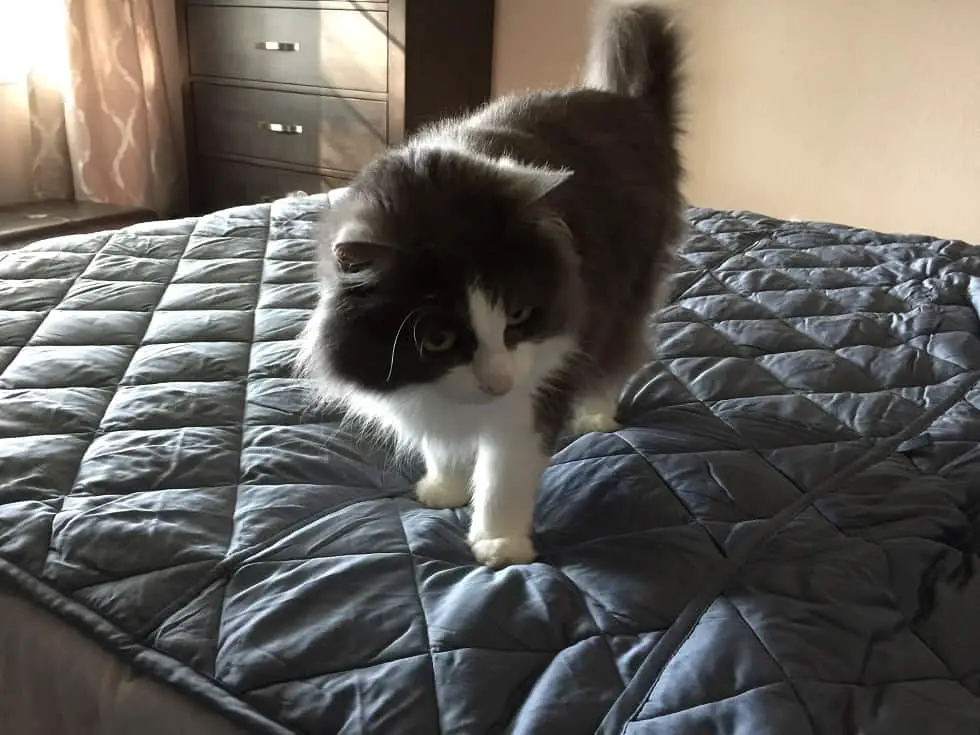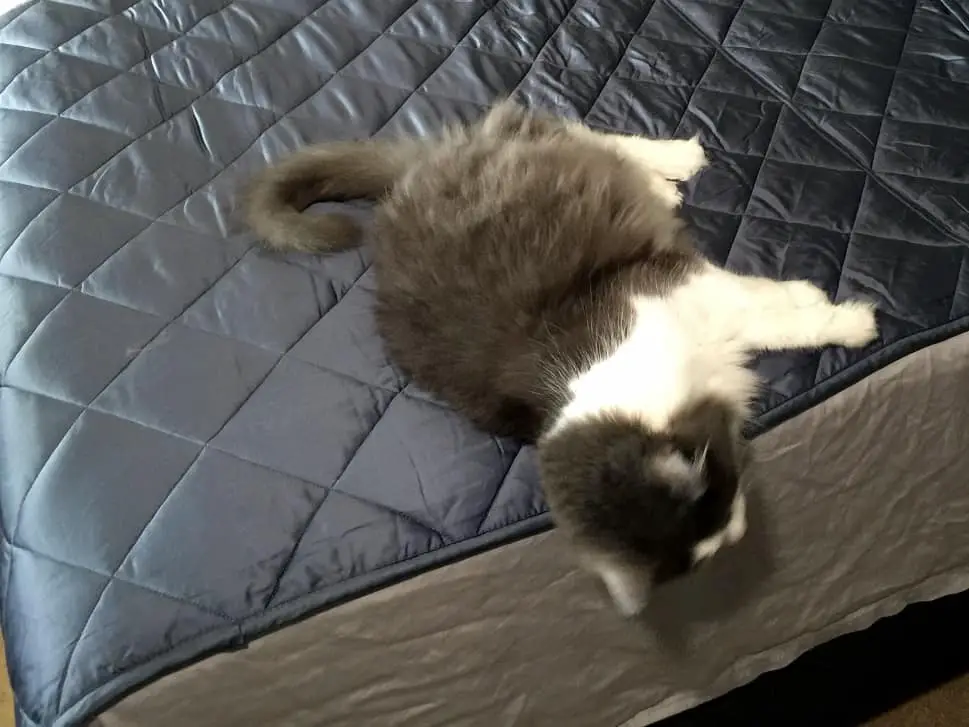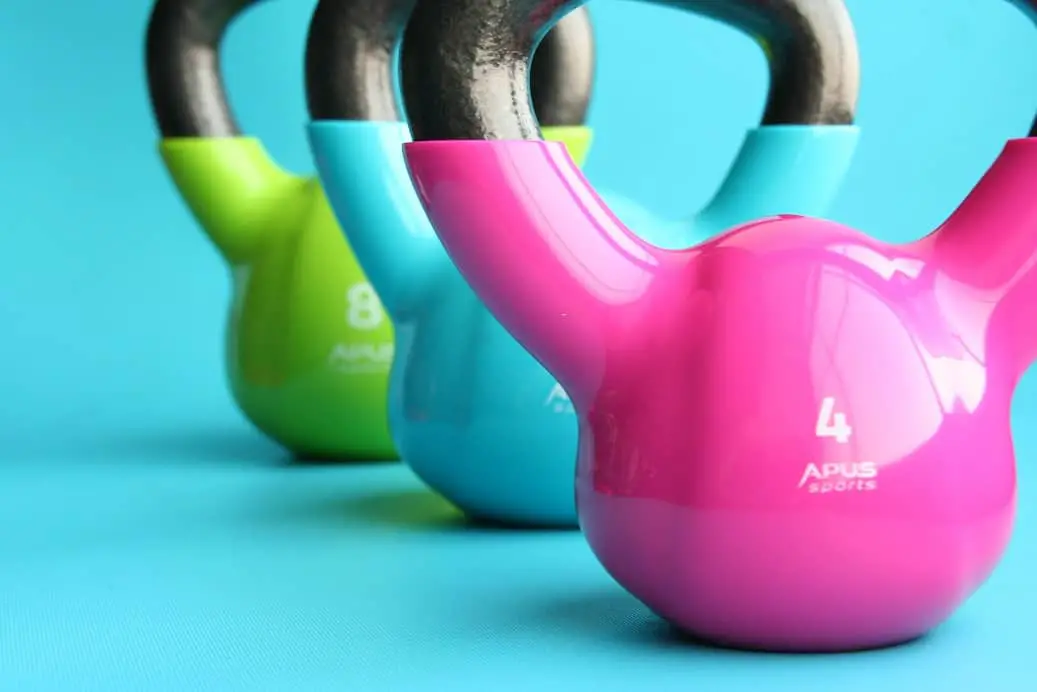Table of Contents
**This page contains affiliate links and I will be compensated if you make a purchase after clicking on my links**
A recent trend in bedding is the addition of the weighted blanket. These blankets may give you the sense that you are being “hugged”. But what is the correct weight?
Choose a weighted blanket that is around 10% of your body weight
For example, if you are 150 lbs. then choose a blanket that weighs 15 lbs.
Fifteen pounds is the weight of a small dog or a large cat.
However, it really comes down to personal preference. You may prefer something slightly lighter, or slightly heavier. If you’re 150 lbs. you may instead prefer 10 lbs. or 20 lbs. Or 30 lbs.
Some have compared the sensation to the lead apron you wear at the dentist for dental X-rays. (Although, personally, that’s only if you go heavy.)
Weighted blankets are not recommended for babies, but for toddlers and children stick with the 10% rule.
Warning: for children and the disabled, make sure they can easily move around and get out from under the weighted blanket
Does weight improve sleep?
Weighted blankets provide “deep touch pressure” which has been found to be relaxing, especially in those suffering from anxiety. The hypothesis is that this calming effect should help you sleep better.
There are also claims that it may help with sleep in those with depression, attention deficit hyperactivity disorder (ADHD), or chronic pain, but the evidence is scant.
Autism spectrum disorder (ASD)
A study by Gingras, et al. published in 2014, studied 67 children age 5 to 16 who had autism spectrum disorder (ASD) and sleep problems. Those with autism tend to suffer from sensory overload which can make falling asleep more difficult.
The children slept with either a regular blanket or weighted blanket for two weeks, then switched blankets for another two weeks.
The authors collected data on Total Sleep Time (TST) which was measured by an accelerometer device on the children’s wrist that measured movement during sleep. The type and duration of movement can be used to determine whether you are asleep or awake.
Unfortunately, they didn’t find any statistically significant difference between the two types of blankets regarding sleep quality. Although the parents did think their children were calmer with the weighted blankets.
A recent meta-analysis reviewed six studies where weighted blankets were used with children with autism spectrum disorder (ASD).
The analysis “slightly favors” using weighted blankets for better and longer sleep in those with ASD but admits that more research is needed.
In other words, the data is a bit weak.

A Weighted blanket under inspection. (Photo by author.)
Insomnia
The study most cited by weighted-blanket enthusiasts is the 2015 study by Ackerley, et al. in which 31 adults with insomnia used a 30-lb weighted blanket for one month.
A statistically significant improvement was found in their sleep quality, compared to sleep before and after the four weeks of weighted blanket use.
In addition, movement also decreased. There was far less tossing and turning.
Obviously, at thirty pounds, the adults weren’t “blinded” to what type of blanket they were sleeping under. Even the authors acknowledge that there wasn’t a true control group.
Control groups are important in studies to account for the placebo effect, which is much more effective than most people realize. If you think it will help you sleep, then it will help you sleep.
So, did their sleep improve because of the weighted blanket or because they believed the weighted blanket would help?
If you sleep better, does it matter?
Is a weighted blanket right for you? You’ll need to judge for yourself.
Important: If you have sleep apnea or any other breathing issues, please consult with your healthcare provider prior to use, as the weight on your chest could be a problem.
The weight in weighted blankets, and other properties
When shopping for a weighted blanket, weight isn’t the only consideration.
What is the correct size?
Yes, weighted blankets come in “twin”, “queen”, and “king” sizes. However, they are smaller than regular blankets. They are not intended to hang over the side of your bed. That would create extra pull and more “weight” than intended.
If you are tall, over 5’5” you may wish either a queen or king. Queen blankets are usually intended for use by a single person. King-sized may be shared.
However, if your partner and you are significantly different in terms of size and weight, you may both wish to have your own blanket with a different weight.
Is the blanket washable?
Blankets filled with glass beads are likely washable, but those filled with plastic or metal beads may not be.
Just because a weighted blanket can be machine-washed doesn’t necessarily mean it should.
What is the weight limit on your washing machine? A fifteen-pound blanket might be okay, but 20 pounds or more may require either a laundromat or professional cleaning.
If washing is important to you, avoid the heavy versions and consider either doubling up or folding a larger blanket in half.
Try to prevent an imbalance in your washing machine by filling it with regular, lightweight laundry.
Does it come with a washable cover? (Or can one be purchased separately?)
Because weighted blankets are smaller than regular blankets, you probably can’t use a standard-size duvet cover, if that was your plan.
Many weighted blankets either come with a cover or sell one separately. The blanket may include ties to attach it to the cover.
Premium versions may even have a zipper, which may be useful if the blanket starts to leak.
The cover may be intended as either “cooling” or “cozy”. The former will be made of cotton or bamboo.
The latter will be described as “minky” which is a furry-feeling plush fabric. Traditionally “minky” fabric is made of polyester, like fleece. Look for versions made of cotton or an alternative breathable fabric.
What is the “weight” in the weighted blanket
In older blankets, the weights were pellets of plastic or metal. Today, most blankets are sold with glass (“silica”) or ceramic beads.
Unlike older materials, when you move around, the glass is silent.
What are the cooling or heating properties of the fabric (including the cover) and other layers?
For more on fabrics that keep you cool, read my post HERE.
In summary, for cooling, cotton is not an ideal fabric. Yes, cotton breathes, but it’s terrible at wicking moisture away from you.
If you are a hot sleeper, look for an alternative, such as bamboo or lyocell (Tencel™). Avoid standard polyester, but more modern high-performance versions are designed to breathe and wick moisture.
Whatever weighted material is used, it will add to heat retention, so if you’re a hot sleeper a weighted blanket may not be for you.

Note that weighted blankets are designed to not hang over the edge. (Photo by author.)
There should be multiple layers to protect the innermost layer holding the beads
You don’t want the beads leaking out. (Especially if you have clawed furry friends.)
- There should be horizontal and vertical stitching, usually a square or diamond pattern, that creates pockets to hold the beads and ensure that they are evenly distributed
If there is a leak, the damage is at least contained to one (or more) isolated pockets.
Sleeping with a weighted blanket
I purchased a weighted blanket of 15 lbs, which is “light” compared to my actual weight (I’m not telling).
Because I’m a hot sleeper, I purchased one made with 100% bamboo fabric and glass beads.
I then placed it directly over a set of cooling sheets.
Night one
Surprising, I found it no hotter than the cooling comforter it replaced. (For context, it’s currently October in Southern California and gets down to around the low 60’s F in my bedroom at night.)
The weight was noticeable but didn’t feel particularly heavy.
I realize that I often have from ten to twenty pounds of concentrated cat lying on parts of me. This is much greater than fifteen pounds of blanket spread out over the square footage of a queen-sized bed.
Night two
To increase the effective weight (eg, thirty pounds), I doubled up the blanket by folding over each side into the middle.
The extra weight felt much more like the dentist’s lead apron. It felt marvelous!
Unfortunately, I woke up in the middle of the night boiling hot.
So much for that experiment.
I may only be able to experience the sensation of extra weight during the cold winter months.
In the meantime, the usual fifteen pounds was manageable.
Does Sleep Position Affect the Preferred Weight of a Weighted Blanket?
[Update] Having spent more time with this and other weighted blankets, I’ve found that heavier-than-recommended weight (eg, 25-30 lbs) is fine for back and stomach sleeping as the weight is evenly distributed over a larger area of your body.
However, if you prefer to sleep on your side, you may wish to stick with the recommended weight (eg, 15 lbs). This is completely anecdotal on my part, but on your side, the weight tends to predominately sit on your hips and legs.
This includes both the top hip under the blanket, but especially the bottom hip, that is now pushed further into the mattress. The mattress may or may not provide adequate support and comfort under the larger weight.
I found my hips to get a bit sore.
Is a weighted blanket right for you or your family? Only you can decide.
Happy dreams!
Top Image: by Pixabay
Want to learn more about the products mentioned?
BONUS video: Sleep under the Weight of a Weighted Blanket
[If you experience issues with menus or links not working, it is most likely due to your Ad blocker.]


